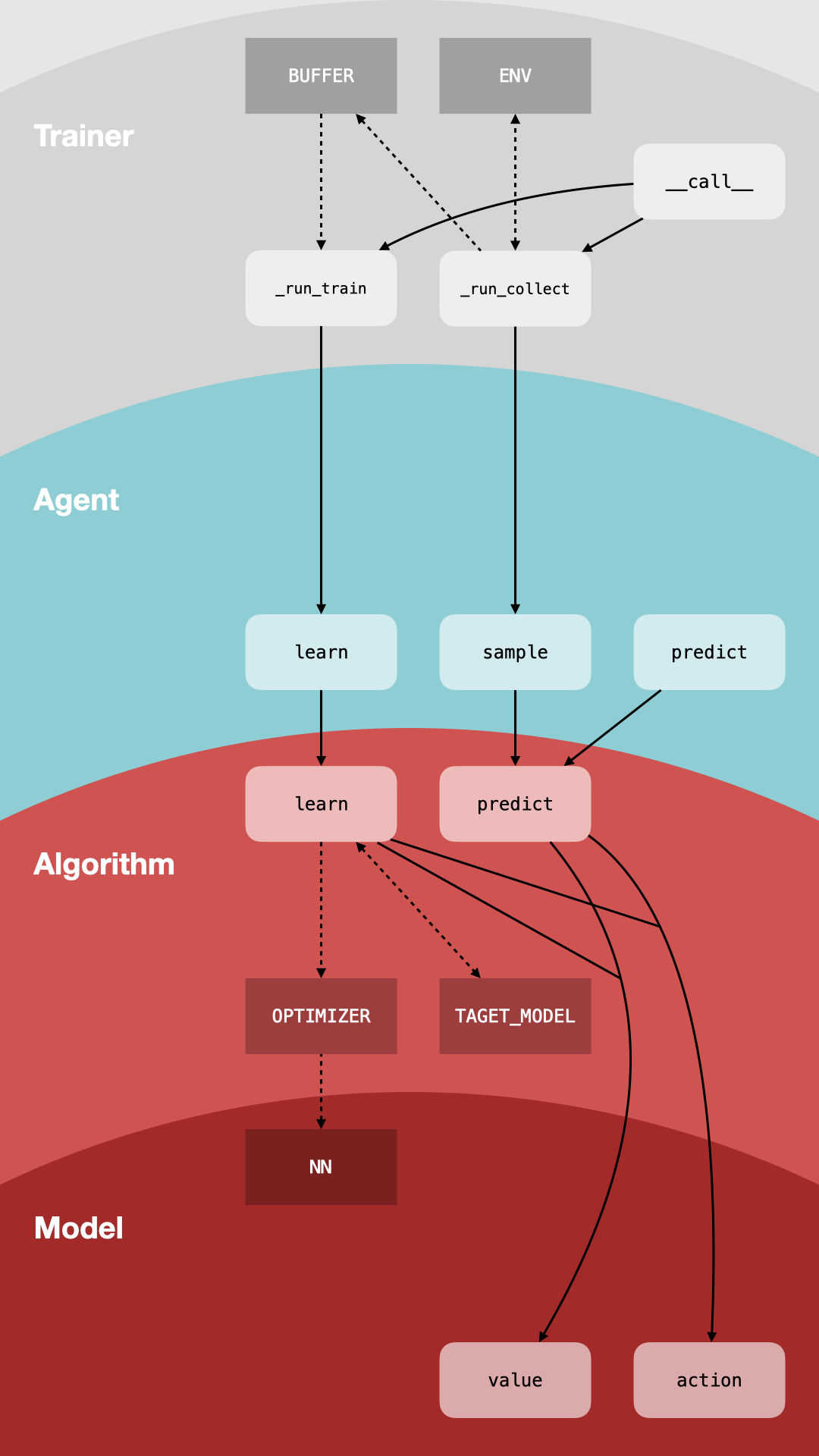Abstractions 🏗
Each algorithm is mainly composed of four classes: Model📦, Algorithm👣, Agent🤖, Trainer🔁 with HAS-A relationship.
Model📦: Define single or multiple forward networks. The input is the observations and the output is the original output of networks.Algorithm👣: Define the mechanism to update parameters in theModel📦and the post-processing of the output ofModel📦(argmax, ...).Agent🤖: A data bridge betweenEnvironment🗺andAlgorithm👣.Trainer🔁: Define the overall training process ofAgent🤖and the tools to assist the training (Buffer,...).
The Trainer.__call__ function returns a generator that holds the training control-flow and all related data. The generator returns a log_data training log at each step, and the generator is called iteratively to complete the training and get all log_data.
The logger📊 part uses Tensorboard and Weights & Biases to record training logs and decorates the Trainer.__call__ function, see the core code for the specific implementation.
Note
🧵 The solid line indicates the control-flow; The dotted line indicates the data-flow.
abstractions.py
class Model(nn.Module):
def __init__(self, **kwargs) -> None:
pass
def value(self, x: torch.Tensor, a: Optional[torch.Tensor] = None) -> tuple[Any]:
# Returns output value of a single or multiple critics
pass
def action(self, x: torch.Tensor) -> tuple[Any]:
# Returns action or action probability distribution
pass
class Algorithm:
def __init__(self, **kwargs) -> None:
self.model = Model(**kwargs)
# 1. Initialize model, target model
# 2. Initialize optimizer
pass
def predict(self, obs: torch.Tensor) -> tuple[Any]:
# Returns action or action probability distribution or Q-function
pass
def learn(self, data: BufferSamples) -> dict[str, Any]:
# Given the training data, it defines a loss function to update the parameters in the Model.
# 1. Computing target
# 2. Computing loss
# 3. Update model
# 4. Returns log_data of train
pass
def sync_target(self) -> None:
# Synchronize model and target model
pass
class Agent:
def __init__(self, **kwargs) -> None:
self.alg = Algorithm(**kwargs)
# 1. Initialize Algorithm
# 2. Initialize run steps variable
pass
def predict(self, obs: np.ndarray) -> np.ndarray:
# 1. obs pre-processing (to_tensor & to_device)
# 2. act = Algorithm.predict
# 3. act post-processing (to_numpy & to_cpu)
# 4. Returns the act used for the evaluation
pass
def sample(self, obs: np.ndarray) -> np.ndarray:
# 1. obs pre-processing (to_tensor & to_device)
# 2. act = Algorithm.predict
# 3. act post-processing (to_numpy & to_cpu & add noise)
# 4. Returns the act used for training
pass
def learn(self, data: BufferSamples) -> dict[str, Any]:
# Data pre-processing
# Calling Algorithm.learn
# Returns return of Algorithm.learn
pass
class Trainer:
def __init__(self, **kwargs) -> None:
self.agent = Agent(**kwargs)
# 1. Initialize args
# 2. Initialize the training and evaluation environment
# 3. Initialize Buffer
# 4. Initialize Agent
pass
def __call__(self) -> Generator[dict[str, Any], None, None]:
# 1. Define the training control-flow
# 2. Returns a generator
pass
def _run_collect(self) -> dict[str, Any]:
# 1. Sample a step and add data to the Buffer
# 2. Returns log_data
pass
def _run_train(self) -> dict[str, Any]:
# 1. Samples data from the Buffer
# 2. Training single step
# 3. Returns log_data
pass
if __name__ == "__main__":
trainer = Trainer()
for log_data in trainer():
print(log_data)
Last update:
2022-12-15
